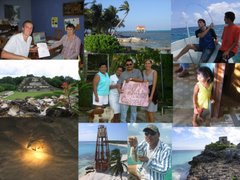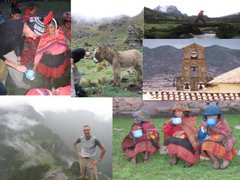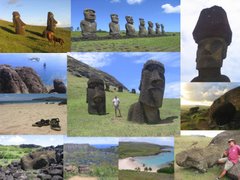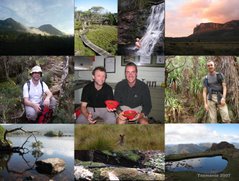 (Mount Everest, aka Sagamartha, aka Chomalongma, aka the Big 'un.)
(Mount Everest, aka Sagamartha, aka Chomalongma, aka the Big 'un.)Back in Kathmandu the atmosphere was as pressurised and hectic as before but it was great to get round some more of the temples and also to meet other travellers - especially Anna and Laura from Italy, who are working as volunteers on childrens welfare projects in Mumbai. They had travelled by bus and train for 3 days to get  to Nepal - now that's real travelling. Best of luck with the return trip guys - hope this time it is free of midnight border crossings manned by immigration officials dressed only in their underpants.
to Nepal - now that's real travelling. Best of luck with the return trip guys - hope this time it is free of midnight border crossings manned by immigration officials dressed only in their underpants.
It was also great to meet up with Adrienne again, if only for 24 hours. Also, Adrienne's laid-back approach to the chaos of Kathmandu was a real eye-opener and left me wondering whether it wasn't I who needed to relax and not Kathmandu... this would be on my mind when I arrived in Delhi with thoughts of changing my travel plans.
Adrienne had only arrived one day and I was leaving the next. The flight to Delhi was the 25th of the big trip by my calculations (I really need to take up Sudoku or something) and pretty unremarkable.
 to Nepal - now that's real travelling. Best of luck with the return trip guys - hope this time it is free of midnight border crossings manned by immigration officials dressed only in their underpants.
to Nepal - now that's real travelling. Best of luck with the return trip guys - hope this time it is free of midnight border crossings manned by immigration officials dressed only in their underpants.It was also great to meet up with Adrienne again, if only for 24 hours. Also, Adrienne's laid-back approach to the chaos of Kathmandu was a real eye-opener and left me wondering whether it wasn't I who needed to relax and not Kathmandu... this would be on my mind when I arrived in Delhi with thoughts of changing my travel plans.
Adrienne had only arrived one day and I was leaving the next. The flight to Delhi was the 25th of the big trip by my calculations (I really need to take up Sudoku or something) and pretty unremarkable.
The 24th flight however was something quite different - one of those once-in-a-lifetime experiences.

On the morning of my last day in Nepal, an already-jet-lagged Adrienne and I got up at 5am to catch a 6.30 flight with Buddha Air (genius) from Kathmandu to... Kathmandu.

This was possibly the world's best scenic flight. In an hour we were whisked (it was a day for cliche and superlatives) to within a few miles of Mt Everest.
(Right - A very excited Adrienne waits for take-off)
What an experience.
I have always had a picture in mind of Everest and the Himalayas. In this picture, the mountains were always firmly part of the landscape. After seeing the mountains towering over the clouds, and seeming almost separate from the landscape, I will never think of them in the same way again!
What an experience.
I have always had a picture in mind of Everest and the Himalayas. In this picture, the mountains were always firmly part of the landscape. After seeing the mountains towering over the clouds, and seeming almost separate from the landscape, I will never think of them in the same way again!
 (Buddha Air - I can think of so many taglines... the plane that takes you to a higher plain?)
(Buddha Air - I can think of so many taglines... the plane that takes you to a higher plain?)  (When can you get into the flight-deck these days? The co-pilot points out some of the highest peaks in the world, including Makalu, Lohtse and Kanchenchunga. Hope my spelling hasn't offended too many mountaineers).
(When can you get into the flight-deck these days? The co-pilot points out some of the highest peaks in the world, including Makalu, Lohtse and Kanchenchunga. Hope my spelling hasn't offended too many mountaineers). (How good is this???!!!!)
(How good is this???!!!!) (If you think this is cheesy you should have seen the t-shirts.)
(If you think this is cheesy you should have seen the t-shirts.)














































